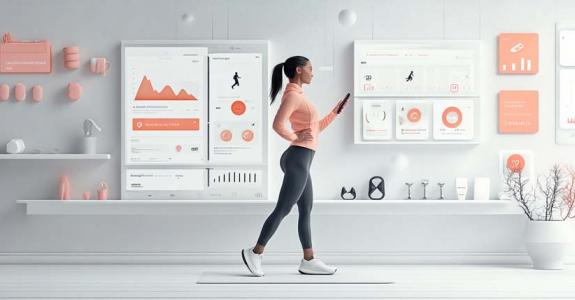In 2025, launching a “decent” fitness app isn’t enough.
Users are overwhelmed with options — and if your product doesn’t deliver real value from day one, they’ll uninstall it by day three.
Great design and clear goals matter, but what truly sets successful fitness apps apart is their feature set — not the number of features, but how well they meet real user needs.
In this article, we’ll cover the must-have features that drive:
- Engagement - users stay active in the app
- Retention - they keep coming back
- Monetization - and they’re willing to pay for more
This guide is for:
- Startup founders- building fitness MVPs
- Product managers - planning next-stage functionality
- Trainers and studio owners - digitizing their services
Let’s break down what to include — and why each feature matters.
User Profiles & Personalization
Before any workout starts, users want to feel like the app “gets” them. That starts with a solid user profile system and grows into meaningful personalization over time.
What to include:
Onboarding with goals and fitness level
Let users define their main objective: weight loss, strength, flexibility, endurance, etc.
Customizable settings
Age, gender, workout frequency, preferred training style (e.g., gym vs. home).
Progress history and achievements
Track milestones, completed sessions, personal records.
Preferences and restrictions
E.g., "no equipment", "low impact", "no cardio", "15-min max"
Why it matters:
- Increases relevance of content
- Helps users build a habit faster
- Forms the foundation for smart recommendations later
🎯 Pro Tip:
Don’t overwhelm users during onboarding.
Collect core data first — then gradually personalize as they engage.
Workout Plans & Scheduling
Whether users are beginners or advanced, structured plans are key to building consistency and progress.
A well-designed fitness app should offer both ready-made and customizable workout plans — tailored to different goals, time availability, and experience levels.
Types of Plans
- Pre-built programs – e.g., “Full Body in 4 Weeks”, “Core Strength for Runners”
- Custom plans – users build or adjust workouts based on goal, duration, equipment
- Short-term challenges – 7- or 30-day commitments with daily goals
- Long-term cycles – periodized programs with progression over 8–12 weeks
Scheduling & Flexibility
- In-app calendar with drag-and-drop sessions
- Rest day configuration
- Rescheduling missed workouts
- Time-based filters (e.g., “I only have 20 minutes”)
- Daily/weekly reminders and motivational nudges
Why it matters:
Structured planning helps users form habits. Flexibility ensures they don’t feel guilty or overwhelmed when life gets in the way.
A good workout scheduling system supports both commitment and freedom — a balance that keeps people engaged.
Activity & Progress Tracking
Tracking is what transforms workouts from random effort into measurable growth.
A solid fitness app should give users clear, motivating insights into their performance — not just numbers, but visual progress that keeps them coming back.
What to Track
- Calories burned per session/day/week
- Steps and distance (via device sensors or wearables)
- Reps, sets, weight used for strength training
- Workout duration and intensity
- Rest times and recovery trends
Progress Visualization
- Clean graphs: weekly/monthly summaries
- Goal indicators: “You’re 80% to your monthly target”
- Badges or streaks for consistency
- Highlight improvements (e.g., “+12% endurance since last month”)
Comparison & Motivation
- “This week vs. last week” insights
- Custom benchmarks (e.g., PRs, total minutes trained)
- Milestone tracking (e.g., first 100 workouts)
Why it matters:
Real-time tracking and historical progress help users feel accomplished, stay motivated, and stick to their plans.
Without feedback, even great workouts can feel like they lead nowhere.
Gamification & Motivation
Fitness goals take time — and motivation doesn’t always last.
That’s where gamification comes in. It transforms daily effort into a rewarding experience, helping users stay consistent, push harder, and actually enjoy the process.
Key Mechanics
- Badges & achievements – unlock for milestones, habits, consistency
- Levels & experience points – progress tied to completed workouts or challenges
- Streaks – daily or weekly activity chains that build habit loops
- Challenges – personal or global (e.g., “Run 20 km this week”)
Rewards & Incentives
- Virtual currency – earn coins for workouts, spend on features or visuals
- Ranking systems – compete with others or against self
- Unlockables – new workouts, avatars, or stats tracking as rewards
Why it matters:
Gamification taps into dopamine, accountability, and social drive.
It’s especially effective for users who aren’t naturally disciplined — and even for those who are, it makes progress feel tangible and fun.
Social Features & Community
Fitness is easier — and often more fun — when you're not alone.
Community-driven features help users stay motivated, build habits, and feel supported. For many, social accountability is stronger than internal willpower.
Core Social Tools
- Comments and feeds – share progress, get reactions
- Groups & tribes – based on location, goals, or workout style
- Messaging or forum threads – discuss plans, ask for advice
Collective Motivation
- Invite friends – train together, even remotely
- Shared goals – complete a challenge as a team
- Leaderboards – weekly rankings for specific workouts or streaks
- Group challenges – e.g., “100K steps as a squad this week”
Feedback & Support
- Likes, encouragement badges, or private cheering
- Coach-to-client communication (if app targets trainers)
- Notifications like “Anna completed 3 workouts this week – cheer her on!”
Why it matters:
Social features increase engagement, retention, and emotional connection.
They turn fitness from a solo struggle into something collaborative — which builds habit and loyalty.
Wearable Integration
Today’s users expect their fitness apps to talk to their devices — from smartwatches to fitness trackers.
Integrating with wearables doesn’t just enhance the user experience — it also boosts accuracy, engagement, and trust.
Supported Devices
- Apple Watch – heart rate, steps, workout sync
- Fitbit – sleep tracking, calories, activity levels
- Garmin, WHOOP, Polar, Samsung Gear – endurance metrics, recovery, VO2 Max
✅ Best practice: Use native SDKs (e.g., Apple HealthKit, Google Fit) to unify data across platforms.
Real-Time Sync & Monitoring
- Live workout tracking – heart rate, reps, pace, etc.
- Sleep & recovery data – inform daily readiness
- Automatic activity logging – no need to press “start workout”
Smart Personalization
- Adjust difficulty based on heart rate
- Recommend rest days based on sleep quality
- Set personalized goals using real data trends
Why it matters:
Wearable integration turns your app from a tool into a smart fitness companion.
It adds depth without requiring extra input — users just train and get smarter feedback.
Payments & Monetization Options
Great features are only half the equation — your app also needs a sustainable revenue model.
Whether you're targeting individual users, corporate clients, or coaches, smart monetization ensures growth and long-term viability.
Common Models
- Freemium – free basic features + paid upgrades (e.g., premium workouts, analytics)
- Subscriptions – monthly/annual plans with full access (often with a trial)
- One-time purchases – unlock full app or specific features once
- Hybrid – combine freemium + subs + in-app purchases
✅ Choose based on audience willingness to pay (see our article on audience analysis)
Premium Access
- Lock advanced plans, analytics, or coaching features
- Offer early access or exclusive content for paying users
- Use soft nudges: "Upgrade to unlock personalized feedback"
Seamless Integration
- App Store / Google Play billing for individual users
- Stripe, PayPal, or Braintree for web or business accounts
- Regional pricing and currency support
Why it matters:
Clear and fair monetization gives users confidence — and gives you flexibility to grow.
Start simple, test, and adapt as your user base evolves.
Smart Recommendations & Adaptive UX
Personalization is no longer a “nice to have” — it’s expected. The most successful fitness apps adapt in real time to user behavior, performance, and preferences.
Smart UX keeps users engaged by making every interaction feel relevant and rewarding.
What to Personalize
- Workout plans – adjust intensity, frequency, or duration based on performance
- Next steps – automatically suggest the next level or new challenge when user completes current plan
- Goal adjustments – refine targets based on user progress or fatigue
- Daily tips or nudges – e.g., “Rest day?” if sleep was poor, or “Push harder” if pace improves
How It Works
- Use workout data, wearable inputs, and engagement history
- Blend rule-based logic with machine learning (if dataset allows)
- Offer manual overrides so users stay in control
Why it matters:
An adaptive interface makes users feel seen and supported — not overwhelmed.
It reduces decision fatigue, boosts motivation, and creates a long-term feedback loop between the app and the user.
UX/UI That Supports Engagement
Design isn’t just about aesthetics — it’s about helping users stay focused, motivated, and in flow.
Great fitness apps don’t just look good — they remove friction, highlight what matters, and guide users toward progress.
Fast & Frictionless Onboarding
- Clear value proposition within first 10 seconds
- 3–5 tap setup: goals → plan → start
- Guest mode or sign-up after first action
- Smart defaults based on behavior or goal
Minimalism with Intentional Focus
- Clean layouts, large buttons, guided structure
- Bold CTAs: “Start workout”, “Log progress”, “Join challenge”
- One primary action per screen — no clutter, no guesswork
Stay in Flow: Distraction-Free UX
- Full-screen workout mode with big timers and swipes
- Disable notifications during sessions
- Preload next exercise to keep transitions smooth
- Audio or haptic cues instead of constant on-screen tapping
Why it matters:
Good design reduces friction. Great design makes progress feel natural.
The smoother the experience, the higher the retention — especially in high-friction contexts like workouts.
Admin Panel & Coach Tools (Optional)
If your app is designed for personal trainers, gyms, or coaching platforms, you’ll need more than just user features — you’ll need backend tools to manage content, clients, and performance.
Who Needs This?
- Fitness studios and clubs offering remote programs
- Personal trainers working with multiple clients
- Online coaching platforms selling custom plans or live sessions
Key Admin Features
- Content management – upload and organize workouts, videos, nutrition plans
- Schedule builder – create and assign plans to clients or groups
- Client management – monitor progress, assign goals, manage access
- Chat & notifications – stay connected with users
- Analytics dashboard – view client activity, retention, results
Why it matters:
If your business model includes coaches or paid programs, a flexible backend is essential.
It gives your team control while keeping the user experience consistent and scalable.
Conclusion: Features That Drive Growth, Not Just Trends
These features aren’t just “nice to have” — they’re core building blocks of a competitive, scalable fitness app.
The right mix of UX, tracking, personalization, and monetization turns a fitness idea into a working product users love.
But that doesn’t mean you need everything on day one.
Start Smart with an MVP
- Focus on features that match your core audience
- Prioritize what solves a real problem
- Keep it lean: 2–3 killer features > 10 underused ones
- Test early and iterate fast
As your user base grows, you can layer in advanced tools like gamification, wearable sync, and adaptive UX — all backed by real behavior data.
📚 Explore Next:
Want to dive deeper into product strategy? Start here:
- How to Choose the Right Fitness App Type for Your Business
- How to Define and Analyze the Target Audience for Your Fitness App
- Step-by-Step Guide to Building a Fitness App
📎 Or talk to us about turning your idea into reality with fitness app development services.






